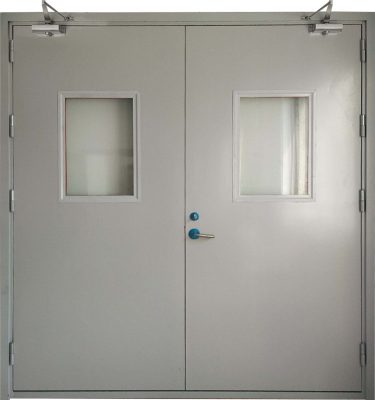Understanding Fire Rated Door: Definitions, Classifications, Installation, and Maintenance
As urbanization accelerates, the demand for building safety and fire protection has intensified. Fire doors play a crucial role in fire safety within buildings. This article aims to provide essential knowledge about fire doors to help you better understand and utilize them.
1. Definition of Fire Rated Doors
A fire door is a specialized door designed to prevent the spread of fire. Its primary function is to contain fire during an incident, allowing time for occupants to evacuate and minimizing property damage.
2. Classifications of Fire Doors
1. By Material:
Wooden Fire Doors: Suitable for residential and some commercial settings.
Steel Fire Doors: The most common type, known for superior fire resistance and security.
Stainless Steel Fire Doors: Ideal for areas requiring hygiene and durability.
Aluminum Fire Doors: Lightweight and corrosion-resistant, often used in commercial buildings.
2. By Fire Rating:
Class A Fire Doors: Provide the longest fire resistance, often exceeding 3 hours.
Class B Fire Doors: Offer moderate fire resistance, typically around 1 to 2 hours.
Class C Fire Doors: Shorter fire resistance, generally 30 to 60 minutes.
Class D Fire Doors: Designed for low-risk areas with a minimum of 30 minutes of fire resistance.
3. By Installation Location:
Exterior Fire Doors: Main entry points to buildings.
Interior Fire Doors: Located within the building, often in corridors and stairwells.
Transom Doors: Installed between exterior and interior doors.
3. Installation of Fire Doors
1. Installation Location: Fire doors should be installed in strategic locations within a building to prevent fire spread, such as in corridors, stairwells, and elevator lobbies.
2. Installation Requirements:
Fit: The door frame must align tightly with the wall, and gaps between the door leaf and frame should be even.
Automatic Closing: Fire doors must be self-closing and free from obstructions.
Fire Seals: Doors should be equipped with fire-rated seals to ensure effectiveness.
Firewall Compliance: Fire doors must be installed on firewalls, matching or exceeding the firewall’s fire rating.
Fire Locks: Equipped with fire-rated locks that ensure the door closes automatically during a fire.

4. Maintenance of Fire Doors
1. Regular Inspections: Fire doors should be inspected regularly for deformities, damage to the frame or leaf, and the condition of seals. Any issues should be addressed immediately.
2. Cleanliness: Keep fire doors clean, regularly wiping the surface of the door and frame. Lubricate locks periodically to maintain functionality.
3. Prohibition of Modifications: Do not modify or dismantle fire doors, as this can compromise their fire-resistance properties.
Conclusion
Fire doors are critical components of building safety, and their effectiveness depends on proper selection, installation, and maintenance. When choosing fire doors, consider the specific needs of the building and adhere to regular maintenance protocols to ensure optimal fire safety performance.
medical door
Knowledge of Fire Doors I. National Standards for Fire Doors Wooden Fire Doors: Grade A wooden fire doors have a leaf thickness of 45-55mm, while Grade B has a thickness of 40-50mm, and Grade C typically measures around 40mm. The door frame's side thickness is 100mm. The selection standards for wood used in fire doors are stringent. Defects such as knots, cracks, and oil spots are eliminated by using first-grade raw lumber, leading to a low material utilization rate—typically below 20% for frames and 28% for door leaf frameworks. This low rate not only increases product costs but also leads to resource wastage. Moreover, the difficulty in impregnation treatment for timber with cross-sectional dimensions exceeding 50mm is a concern. Therefore, developed countries commonly use flame-retardant engineered wood to manufacture wooden fire door frames and leaf structures. Steel Fire Doors: Steel fire doors are categorized by fire resistance ratings: Grade A (≥1.2 hours), Grade B (≥0.9 hours), and Grade C (≥0.6 hours). Based on usage requirements and specifications, they can be single-leaf, double-leaf, with or without glass, and various configurations that meet the needs of fire safety. II. Classification Fire doors can be classified based on their operational status into two types: Normally Open Fire Doors: These doors remain open during normal conditions and automatically close during a fire event. Normally Closed Fire Doors: These doors remain closed but require manual operation to open. A challenge arises with normally closed fire doors, particularly in high-traffic areas such as large shopping malls, where frequent opening can lead to wear and eventual malfunction. To mitigate this risk, normally open fire doors are recommended for evacuation staircases, utilizing various sensors to ensure they close automatically during a fire. III. Measurement for Fire Doors Accurate measurement of the door opening is critical. Key considerations include: Benchmark Height: Determine the position of the benchmark line and adjust accordingly for the door height. Measurement Techniques: For non-standard openings, measure the width at three points (top, middle, bottom) and the height at two points (left, right), taking the smallest dimensions. Opening Direction: Specify whether a single leaf door opens left or right, optimizing for traffic flow. Fire Door Specifications: Include the name and purpose of the door (e.g., service shaft doors, corridor doors). Lock Selection: Choose appropriate locks for the type of fire door being installed. Color and Finish: Follow project specifications or manufacturer recommendations for colors. Additional Features: Consider if the door should have windows, whether they should be hollow or solid, and other specific requirements. IV. Custom Fire Door Manufacturing When custom-making fire doors, the dimensions typically reduce by 2cm from rough openings and 1cm from finished openings. Adhering to precise measurement steps ensures accurate manufacturing. V. Fire Door Installation Installation Tools Required tools include electric drills, hammers, chisels, saws, squares, and levels. Installation Steps Assembling the Door Frame: Begin by securing the frame components and checking alignment. Connecting the Frame to the Wall: Insert the assembled frame into the opening, ensuring it is level and plumb. Installing the Door Leaf: Attach the door leaf, ensuring correct alignment and that it swings freely. Finishing Touches: Install the door trim and seal all gaps for insulation and fire protection. Quality Control Standards Ensure smooth operation of the door lock and leaf. Maintain consistent gaps around the door leaf. Verify structural integrity and aesthetic finish. Conclusion As a fire door manufacturer, Yunnan Guangdun Door Industry Co., Ltd. emphasizes quality compliance with national standards. Understanding the specifics of fire door construction, measurement, and installation is crucial in ensuring safety and efficiency. For more information on our fire doors and to discuss your requirements, please contact us.


